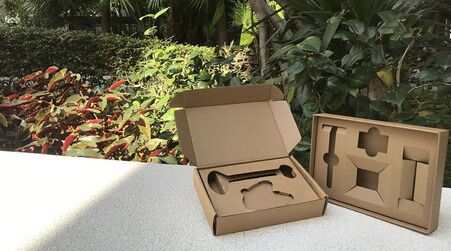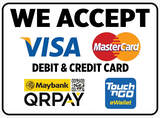Custom Printed Packaging Inserts
Custom box inserts, also known as packaging inserts or packaging inlays, are used to ensure your products are secure inside your box. These can come in the form of paper inserts, cardboard inserts, or foam inserts. Other than product protection, custom inserts allow you to present your products beautifully during the unboxing experience. If you have multiple items in one box, packaging inserts are a great way to position each product just the way you'd like. What's better is that you can fully customize each box insert with your branding! Take a look at our box insert guidelines, or simply get inspired with a selection of ideas for box inserts.
An Upgraded Unboxing ExperienceFully customizable
Customize your paper and cardboard inserts with full print and designs that pair beautifully with your boxes. Sturdy and durable
Custom box inserts are tailored to the precise size of your products, keeping them secure in transit while giving your customers a truly elevated unboxing experience. MOQ from 300 units
Minimums starting from 300 units per size or design when ordered with the outer box. Standalone box inserts start with an MOQ of 500 units. |
|
Structurally Engineered to Perfection
Creating the optimal insert design requires more than meets the eye. Products come in various shapes, sizes, and weights, which means using the right materials, creating structures to securely hold each product, and ensuring the insert fits precisely with the outer box. Most brands don't have a structural design team, which is where we can help! Start a structural design project with us and we'll help you bring your packaging vision to life. |
Common Insert Structure
With custom box inserts, there's no 'one size fits all'. The size, weight, and position of products all affect how the insert needs to be structured to secure each product. For reference, here are some examples of common insert structures.
With custom box inserts, there's no 'one size fits all'. The size, weight, and position of products all affect how the insert needs to be structured to secure each product. For reference, here are some examples of common insert structures.
|
Box Insert (No Backing)
Most commonly used for products that can sit directly at the base of the box and don't need to be elevated. These types of inserts are also ideal for products of the same size. |
Box Insert (With Backing)
Most commonly used for products of the same/similar size that need to be elevated in order to fit securely in the insert. Otherwise, the products will fall through. |
Box Insert (Multiple Backings)
Most commonly used for products of different sizes that need to be elevated in order to fit securely in the insert. Each backing is tailored to the size of the product and ensure they don't fall through the insert. |
Technical Specs: Custom Box Insert
An overview of the standard customizations available for custom box inserts.
An overview of the standard customizations available for custom box inserts.
Corrugated Materials
|
Box dividers that are corrugated (the wavy lines in cardboard) are stronger and ensure the divider walls are sturdy. Corrugated dividers are typically used for heavier items, fragile items, or items that will be shipped and need extra cushioning/protection
|
E-flute
Most commonly used option and has a flute thickness of 1.2-2mm |
B-flute
Ideal for large boxes and heavy items, with a flute thickness of 2.5-3mm |
|
Designs are printed on these base materials which is then glued to the corrugated board. All materials contain at least 50% post-consumer content (recycled waste).
|
White
Clay Coated News Back (CCNB) paper that's most ideal for printed corrugated solutions WhiteClay Coated News Back (CCNB) paper that's most ideal for printed corrugated solutions |
Brown Kraft Paper
Unbleached brown paper that is ideal for only black or white print. |
Non-corrugated Materials
|
Box inserts that are paper based and not corrugated are typically used for lightweight, non-fragile items. These paper based inserts used a standard thickness of 300-400gsm, and contain at least 50% post-consumer content (recycled waste).
Box inserts can also be made of foam, which are best for fragile items such as jewelry, glass or electronics. However, foam inserts are the least eco-friendly and cannot be printed on. |
White Paper
Solid Bleached Sulfate (SBS) paper that yields high quality print. PE Foam Polyethylene foam resembles a sponge-like material. Available in black or white. |
Brown Kraft
Unbleached brown paper that is ideal for only black or white print. EVA Foam Ethylene Vinyl Acetate foam resembles a yoga mat material. Available in black or white. |
|
All packaging is printed with soy-based ink, which is eco-friendly and produces much brighter and vibrant colors
|
CMYK
CMYK is the most popular and cost effective color system used in print |
Pantone
For accurate brand colors to be printed and is more expensive than CMYK. |
Coating
|
Coating is added to your printed designs to protect it from scratches and scuffs
|
Varnish
An eco-friendly water-based coating but doesn't protect as well as lamination |
Lamination
A plastic coated layer that protects your designs from cracks and tears, but not eco-friendly. |
Finishes
|
Top off your packaging with a finish option that completes your package.
|
Matte
Smooth and non-reflective, overall softer look. Satin Semi-shiny, in between a matte and glossy look. |
Glossy
Shiny and reflective, more prone to fingerprints. Soft touch Looks like a matte finish, but feels like velvet. |
Related Products and Services:



















